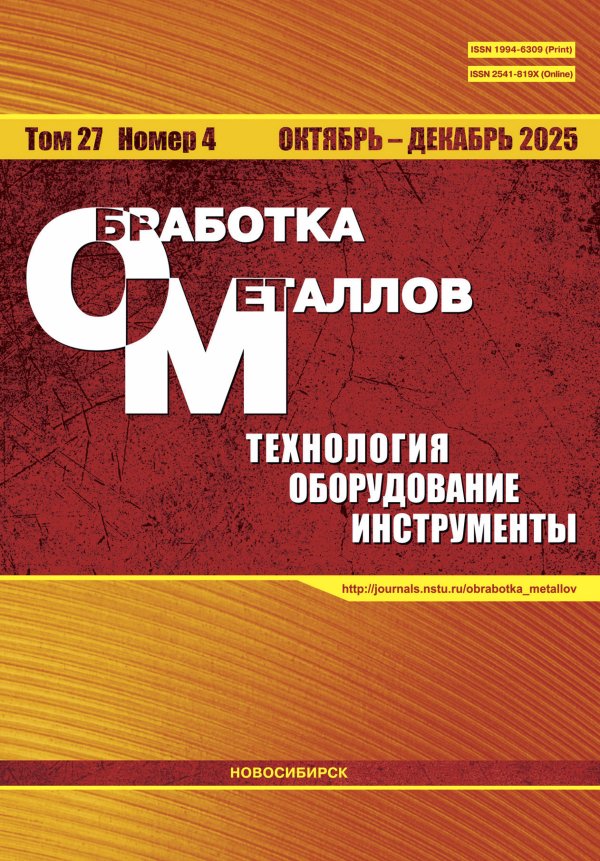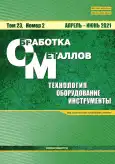Контроль зазоров в конструкциях технических изделий в процессе вибрационных испытаний
- Авторы: Тестоедов Н.А.1, Бернс В.А.1, Жуков Е.П.1, Лысенко Е.А.1, Лакиза П.А.1
-
Учреждения:
- Выпуск: Том 23, № 2 (2021)
- Страницы: 40-53
- Раздел: ОБОРУДОВАНИЕ. ИНСТРУМЕНТЫ
- URL: https://bakhtiniada.ru/1994-6309/article/view/301939
- DOI: https://doi.org/10.17212/1994-6309-2021-23.2-40-53
- ID: 301939
Цитировать
Аннотация
Об авторах
Н. А. Тестоедов
доктор техн. наук, профессор, «Информационные спутниковые системы» имени академика М. Ф. Решетнёва, ул. Ленина, 52, г. Железногорск, 662972, Россия, testoedov@iss-reshetnev.ru
В. А. Бернс
Email: v.berns@yandex.ru
доктор техн. наук, профессор, 1. Сибирский научно-исследовательский институт авиации имени С.А. Чаплыгина, ул. Ползунова, 21, г. Новосибирск, 630051, Россия; 2. Новосибирский государственный технический университет, пр. К. Маркса, 20, г. Новосибирск, 630073, Россия , v.berns@yandex.ru
Е. П. Жуков
Email: zh-ep@yandex.ru
канд. техн. наук, Сибирский научно-исследовательский институт авиации имени С.А. Чаплыгина, ул. Ползунова, 21, г. Новосибирск, 630051, Россия, zh-ep@yandex.ru
Е. А. Лысенко
Email: mla340@iss-reshetnev.ru
канд. техн. наук, «Информационные спутниковые системы» имени академика М. Ф. Решетнёва, ул. Ленина, 52, г. Железногорск, 662972, Россия, mla340@iss-reshetnev.ru
П. А. Лакиза
Email: qinterfly@gmail.com
Сибирский научно-исследовательский институт авиации имени С.А. Чаплыгина, ул. Ползунова, 21, г. Новосибирск, 630051, Россия, qinterfly@gmail.com
Список литературы
- Tiwari R. Rotor Systems: analysis and identification. – Boca Raton: CRC Press, 2017. – 1069 p. – ISBN 978-1-138-03628-4.
- Bachschmid N., Pennacchi P., Tanzi E. Cracked rotors: a survey on static and dynamic behaviour including modelling and diagnosis. – Berlin; Heidelberg: Springer-Verlag, 2010. – 408 p. – ISBN 978-3-642-01485-7.
- Костюков В.Н., Науменко А.П. Основы виброакустической диагностики и мониторинга машин: учебное пособие. – Омск: Изд-во ОмГТУ, 2011. – 360 с. – ISBN 978-5-8149-1101-8.
- Неразрушающий контроль. Т. 7, кн. 2. Вибродиагностика: справочник / Ф.Я. Балицкий, А.В. Барков, Н.А. Баркова и др. – М.: Машиностроение, 2005. – 829 с. – ISBN 5-217-03298-7.
- Жуков Р.В. Обзор некоторых стандартов ISO/TC-108 в области диагностики машинного оборудования // Контроль. Диагностика. – 2004. – № 12. – С. 61–66.
- Zhuge Qi, Lu Yongxiang, Yang Shichao. Non-stationary modelling of vibration signals for monitoring the condition of machinery // Mechanical Systems and Signal Processing. – 1990. – Vol. 4, iss. 5. – P. 355–365.
- Lacey S.J. Using vibration analysis to detect early failure of bearings // Insight – Non-Destructive Testing and Condition Monitoring. – 2007. – Vol. 49, iss. 8. – P. 444–446.
- Litak G., Friswell M.I. Dynamics of a gear system with faults in meshing stiffness // Nonlinear Dynamics. – 2005. – Vol. 41, iss. 1–3. – P. 415–421. – doi: 10.1007/s11071-005-1398-y.
- Вибродиагностика авиационных конструкций. – М.: ГосНИИГА, 1986. – 95 с. – (Труды Государственного научно-исследовательского института гражданской авиации; вып. 256).
- Постнов В.А. Определение повреждений упругих систем путем математической обработки частотных спектров, полученных из эксперимента // Известия Российской академии наук. Механика твердого тела. – 2000. – № 6. – С. 155–160.
- Косицын А.В. Метод вибродиагностики дефектов упругих конструкций на основе анализа собственных форм колебаний // Приборы и методы измерений. – 2011. – № 2 (3). – С. 129–135.
- Perera R., Fang S.E., Huerta C. Structural crack detection without updated baseline model by single and multi-objective optimization // Mechanical Systems and Signal Processing. – 2009. – Vol. 23, iss. 3. – P. 752–768. – doi: 10.1016/j.ymssp.2008.06.010.
- Dilena M., Morassi А. Damage detection in discrete vibrating systems // Journal of Sound and Vibration. – 2006. – Vol. 289. – P. 830–850. – doi: 10.1016/j.jsv.2005.02.020.
- Xu M., Wang S., Jiang Y. Structural damage identification by a cross modal energy sensitivity based mode subset selection strategy // Marine Structures. – 2021. – Vol. 77. – P. 1–22. – doi: 10.1016/j.marstruc.2021.102968.
- Barbieri N., Barbieri R. Study of damage in beams with different boundary conditions // International Journal of Civil, Environmental, Structural, Construction and Architectural Engineering. – 2013. – Vol. 7, iss. 6. – P. 399–405.
- Damage identification and health monitoring of structural and mechanical systems from changes in their vibration characteristics: a literature review. Technical Report LA-13070-MS / Los Alamos National Laboratory; S.W. Doebling, C.R. Farrar, M.B. Prime, D.W. Shevitz. – Los Alamos, NM, 1996. – 132 p.
- Викторов И.А. Физические основы применения ультразвуковых волн Рэлея и Лэмба в технике. – М.: Наука, 1966. – 169 с.
- Worlton D.С. Ultrasonic testing with Lamb waves // Non-Destructive Testing. – 1957. – Vol. 15, iss. 4. – P. 218–222.
- Worlton D.C. Experimental confirmation of Lamb waves at megacycle frequencies // Journal of Applied Physics. – 1961. – Vol. 32. – P. 967–971.
- Kessler S.S., Spearing M.S., Soutis C. Structural health monitoring in composite materials using Lamb wave methods // Smart Materials and Structures. – 2002. – Vol. 11. – P. 269–278. – doi: 10.1999/1307-6892/9351.
- Zaitsev V., Sas P. Nonlinear response of a weakly damaged metal samle // Journal of Vibration and Control. – 2000. – Vol. 6. – P. 803–822.
- Бовсуновский А.П., Матвеев В.В. Вибродиагностические параметры усталостной поврежденности упругих тел // Механічна втома металів. Праці 13-го Міжнародного колоквіуму (МВМ-2006), 25–28 вересня 2006 року. – Ternopil, 2006. – P. 212–218.
- Цыфанский С.Л., Бересневич В.И., Лушников Б.В. Нелинейная вибродиагностика машин и механизмов. – Рига: Рижский техн. ун-т, 2008. – 366 с. – ISBN 978-9984-32-194-3.
- Diana G., Bachmid N., Angel F. An on-line crack detection method for turbo generator rotors // Proceedings of International Conference on the Rotordynamics, JSME, September 14–17, 1986, Tokyo. – Tokyo, 1986. – P. 385–390.
- Контроль соосности установки отклоняемых поверхностей по результатам вибрационных испытаний / В.А. Бернс, А.П. Бобрышев, В.Л. Присекин, В.Ф. Самуйлов // Вестник Московского авиационного института. – 2008. – Т. 15, № 1. – С. 87–91.
- Способ контроля люфтов в механических проводках управления самолетов / В.А. Бернс, А.П. Бобрышев, В.Л. Присекин, А.И. Белоусов, В.Ф. Самуйлов // Полет. – 2007. – № 12. – С. 50–53.
- Al-Khazali H.A.H., Askari M.R. Geometrical and graphical representations analysis of Lissajous figures in rotor dynamic system // IOSR Journal of Engineering. – 2012. – Vol. 2 (5). – Р. 971–978.
- Бернс В.А., Долгополов А.В. Контроль зазоров в подвижных соединениях по результатам резонансных испытаний // Вестник СибГАУ. – 2013. – № 6 (52). – С. 149–153.
- Опыт контроля дефектов летательных аппаратов по параметрам вибраций / В.А. Бернс, Е.А. Лысенко, А.В. Долгополов, Е.П. Жуков // Известия Самарского научного центра РАН. – 2016. – Т. 18, № 4. – С. 86–96.
- Диагностирование трещин в металлических панелях по нелинейным искажениям портретов колебаний / В.А. Бернс, Е.П. Жуков, В.В. Маленкова, Е.А. Лысенко // Обработка металлов (технология, оборудование, инструменты). – 2018. – Т. 20, № 2. – С. 6–17. – doi: 10.17212/1994-6309-2018-20.2-6-17.
Дополнительные файлы







